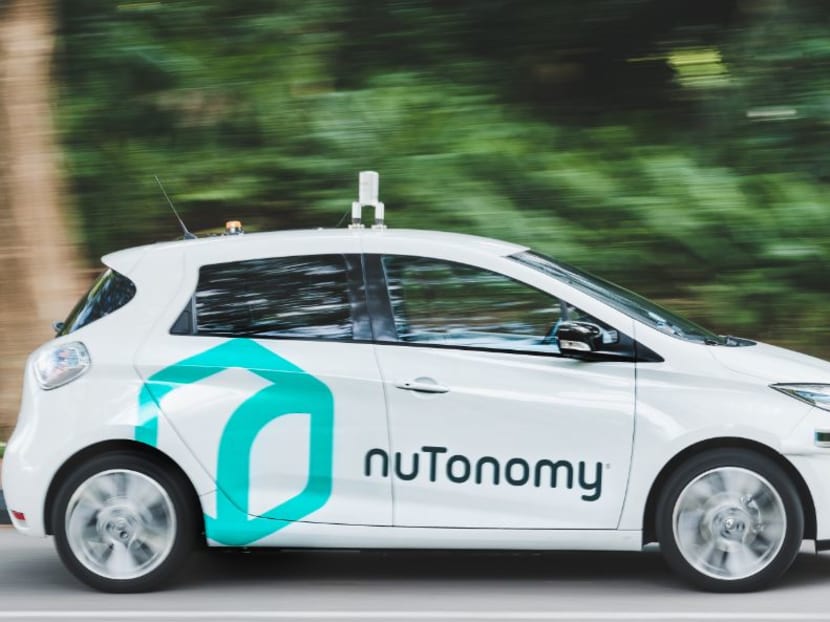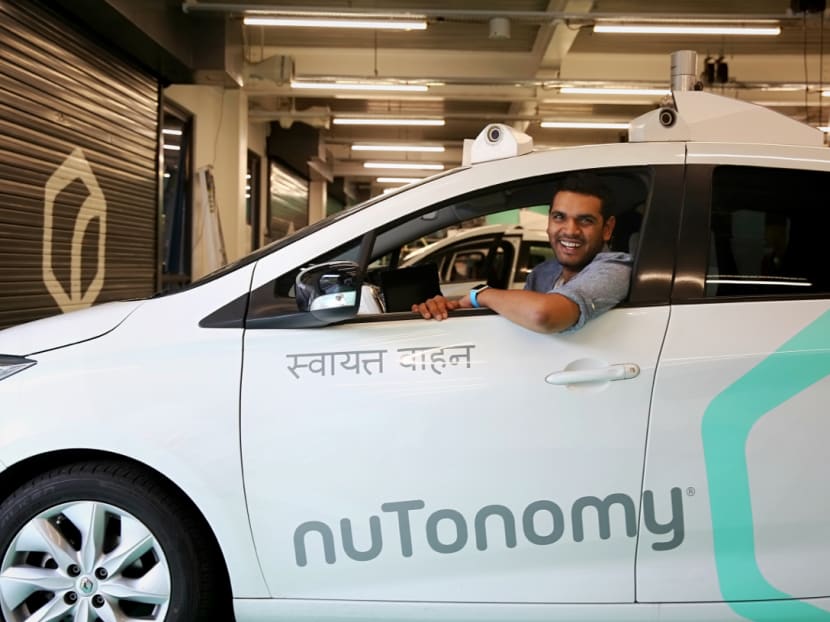The Future of Work: No more bad drivers? Making self-driving cars smarter than humans
As the world readies itself for driverless cars, engineers are working towards coming up with a system that will overtake human abilities in making a split-second decision.

Autonomous vehicles are typically fitted with high-tech tools to gather information, including cameras, sensors, radar, and light detection and ranging technology, otherwise known as Lidar technology.
Late last year, a study by consulting firm McKinsey estimated that almost a quarter of work activities in Singapore could be displaced by 2030. At the same time, however, a vast amount of jobs will be created, with new technologies spawning many more jobs than they destroyed, the study pointed out. The introduction of the personal computer, for example, has enabled the creation of 15.8 million net new jobs in the United States in the last few decades, even after accounting for jobs displaced.
In a new weekly series, TODAY looks at The Future of Work — the emerging jobs fuelled by technological advancements which may not even have existed a few years back, but are set to proliferate within the next decade or so. In the seventh instalment, we feature the people steering the course of autonomous vehicle technology.
SINGAPORE — Seated in a moving vehicle where he is not touching the steering wheel is Mr Karan Shetti. The senior software engineer with nuTonomy is trying to programme, through artificial intelligence (AI) systems, a self-driving car so that it not just behaves like a human driver but reacts faster than one.
The 30-year-old, who joined the Singapore-based start-up last May after a six-year stint with aircraft manufacturer Airbus, is responsible for making sure the car works safely and understands and reacts properly to its surroundings, which can sometimes include erratic human behaviour such as motorists suddenly switching lanes or falling asleep at the wheel, or a child dashing across the road.
Mr Shetti has to keep designing and redesigning algorithms so that the driverless car can identify pedestrians and objects such as other vehicles, trees or even animals on the roads. And that is just one part of the work at the company which is developing software to power these vehicles.
It is obviously not possible for him to programme every scenario that the car may encounter, so he has to also collect information and run it through the algorithm. As it collects, processes and chooses the right actions based on the information gathered, the car gets to "learn" and "understand" more of what is happening around it.
Autonomous vehicles are typically fitted with high-tech tools to gather information, including cameras, sensors, radar, and light detection and ranging technology, otherwise known as Lidar technology.
All of nuTonomy's 12 vehicles use Lidar, which is the crucial hardware and box-like unit that is mounted on the car roof. Instead of sending out radio waves like a radar, Lidar emits pulses of infrared light that is invisible to the naked eye and measures how long it takes for the light to return after hitting nearby moving or stationary objects. The results are condensed to produce a 3D map in real time to identify objects. Once the car recognises the object, the AI will then tell it what to do.
Having an algorithm that can read all types of objects on and off the roads, or detect weather changes, is vital, Mr Shetti said, because it is "not enough for the car to react in a human-like manner".
"It has to be a smarter and better driver than a human being."

Mr Karan Shetti is a senior software engineer with nuTonomy. Photo: Nuria Ling/TODAY
Equipped with sensors that provide a 360-degree view of its surroundings, the self-driving car would be able to activate the brakes just in time to avoid hitting another vehicle upfront, for instance, because the algorithm is able to calculate the distance between the two vehicles.
In another scenario, the car would also know where to swerve, depending on whether there are objects in the direction it is heading.
Accidents occur, not only due to environmental factors, but also because of human fatigue. There have been cases of drivers hitting pedestrians who had the right of way because they were not alert at night.
"But there is no such thing as fatigue for autonomous vehicles, Mr Shetti said. "Having the perfect algorithm would ensure a safe and efficient drive."
TESTS AND MORE TESTS
Across countries, the self-driving car is seen as the next leap for the automobile industry. While Google and Volvo have been testing autonomous cars on public roads in other countries for several years, Singapore took the lead to deploy driverless vehicles when nuTonomy was given approval by authorities to launch a trial for self-driving taxis here.
Aside from autonomous cars and taxis, driverless trucks and buses have been plying Singapore's roads as part of trials, with certain areas such as the one-north district and Nanyang Technological University (NTU) designated as testing sites.
At NTU, a two-hectare test facility for autonomous vehicles — unveiled last November — was designed to replicate public roads here, with traffic lights, infrastructure and rules in place. The circuit also features a rain simulator and flood zone to test the navigation abilities of the driverless vehicles under different weather conditions.
Even in the United States, trials are still ongoing, signalling the reticence among developers to roll out autonomous vehicles fully because the technologies have yet to be perfected.
And they have a right to be concerned. In March this year, an Uber driverless car hit a woman crossing a street in the US state of Arizona — believed to be the first pedestrian death linked to autonomous technology. Following the accident, Uber suspended testing not only in the state but others including San Francisco and Pittsburgh.
In Singapore, there has been at least one known accident at one-north involving a lorry and a nuTonomy driverless taxi in October 2016. This forced a short suspension of the trial.
So far, nuTonomy has not set a committed timeline for when its driverless vehicles will be rolled out for wider use because more tests have to be conducted.
Saying that it plans to launch a public pilot of an autonomous mobility service in the "not-so-distant future", the firm's chief operating officer Doug Parker, however, noted that "with each month that passes, the speed of our development is accelerating faster and faster".
He added: "This isn't a question of speed, it's a question of process. Our vision is not to take over all public roads with autonomous vehicles overnight, rather, our priority is to be very precise in the development of premier autonomous vehicle software that is safe and reliable."
Similarly, the use of driverless trucks by Belgium-based logistics and engineering firm Katoen Natie remains at the pilot stage, and the software used by the trucks still needs some fine-tuning.
Currently, one truck is being test, and another 11 will be put on trial at a later date.
The autonomous trucks were built by Dutch vehicle manufacturer VDL Groep, and have been used in operations at ExxonMobil's manufacturing hub at Jurong Island as part of a trial launched last October.
Katoen Natie's project manager Wallace Tay, 50, said that the truck's sensors are "very sensitive", such that the vehicle would come to a standstill if it detects an empty sack lying in its path, for example.
The truck will then send an alert to the control command centre, which will investigate if there is a real obstacle.
"False alarms do occur occasionally," Mr Tay added. "So, we still have to conduct tests to see what issues might crop up before we properly roll (the fleet) out."
PUSHING THE FRONTIER
The rounds of tests and improvements may sound laborious, but Mr Shetti sees it differently. He switched lines because he had an itch to work on projects that can move from concept to application quickly.
"In big firms, some projects tend to drag out because they have many things to look at. But in start-ups… they come up with an idea, try to test it out, and then refine it," he said.
The computer engineering graduate from NTU, who built his own computer game at age 13, had always wanted to work on the "next big thing".
"Previously, people work from laptops, then smartphones came about. And later, mobile apps were created. It's always about what's next and that, to me, is captivating," he added.
Describing his job at nuTonomy as both "exciting and frustrating", he said: "You think you got it right, but not exactly. And that can be annoying sometimes. But having to figure out how the algorithm can be better is challenging, and you learn new things every day."
With the self-driving vehicle sector set to progress from the research-and-development stage to deployment, Mr Parker from nuTonomy said that jobs available will not just be confined to roles such as software engineers and research scientists. The firm has a team of more than 100 people in Singapore.
Technicians will be needed to maintain the cars, including their sensors and computers. The firm's website now lists more than 20 job vacancies, with roles ranging from test engineers to safety drivers.
There are concerns that once these vehicles take to the roads, businesses could potentially retrench drivers.
At Katoen Natie, the firm is showing that this is not likely to happen because the human mind is still needed to do a share of work and there are new roles to be assigned.
Mr Tay said that most of its 24 drivers are in their 20s and 30s. For the older workers, they were afraid they might lose their jobs and were unsure of their ability to learn the new technology used to operate the trucks.
"What we're doing is upgrading their skills, and putting them in higher-quality jobs. After we explained this to the drivers, they understood and were keen to try on the new role."
'MORE FUN THAN IT LOOKS'
Still, the firm had difficulty finding younger drivers to test the crawling driverless trucks.
"Imagine driving at 25km/h under a hot sun, and especially after lunch," Mr Tay said with a laugh. "The younger generation would not want to do such work. They want something more interesting and exciting."
One younger hire was 26-year-old Muhd Naszri Shah. He is the first among the firm's drivers to remotely manage the driverless truck, with plans to train the other drivers to perform a similar role.
Stationed at the firm's command control centre located at Jurong Island, he has to plan the routes the trucks will take for the day, among other tasks.
To do that, Mr Naszri — who studied automotive technology at the Institute of Technical Education — has to understand the volume of goods to be transferred, which would determine the number of trips the trucks have to make.
Then, he would determine the routes for the truck and remotely monitor it from the command centre.
The vehicles transport products between the company's packaging and intermediate storage facilities, covering a round-trip distance of about 6km to 8km.
This is a very different job scope from what he had before. Mr Naszri joined Katoen Natie in 2014, having worked as a driver in the construction industry, ferrying sand and soil to and from construction sites.
"Now, I'm learning about new technology and how to remotely manage the driverless truck. It's much more fun, in a way," he said, adding that it took time for him to get familiar with the computer systems.
He kept a "positive mindset" as he was learning and did his own research for things he could not grasp. "You have to understand that the world keeps changing, jobs keep changing. You have to go with the flow."






